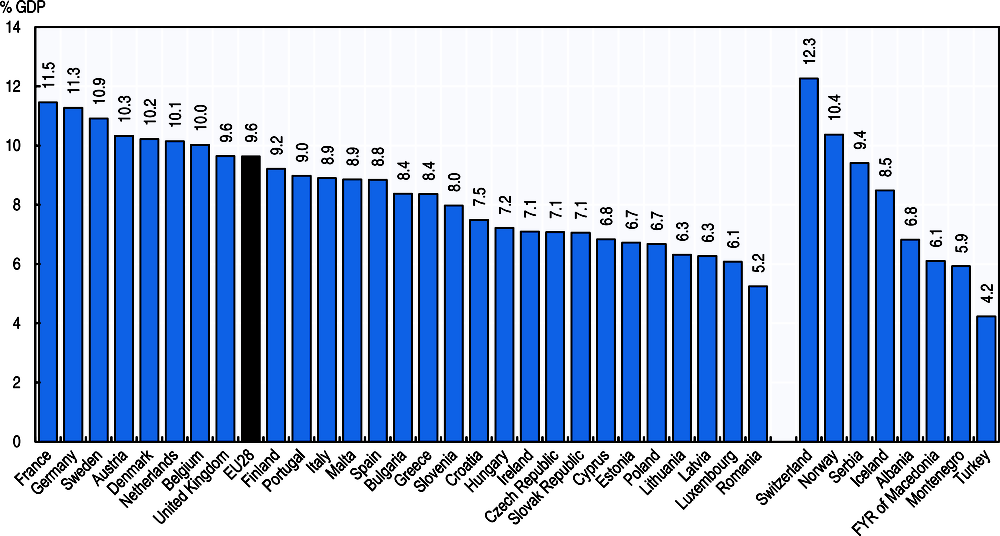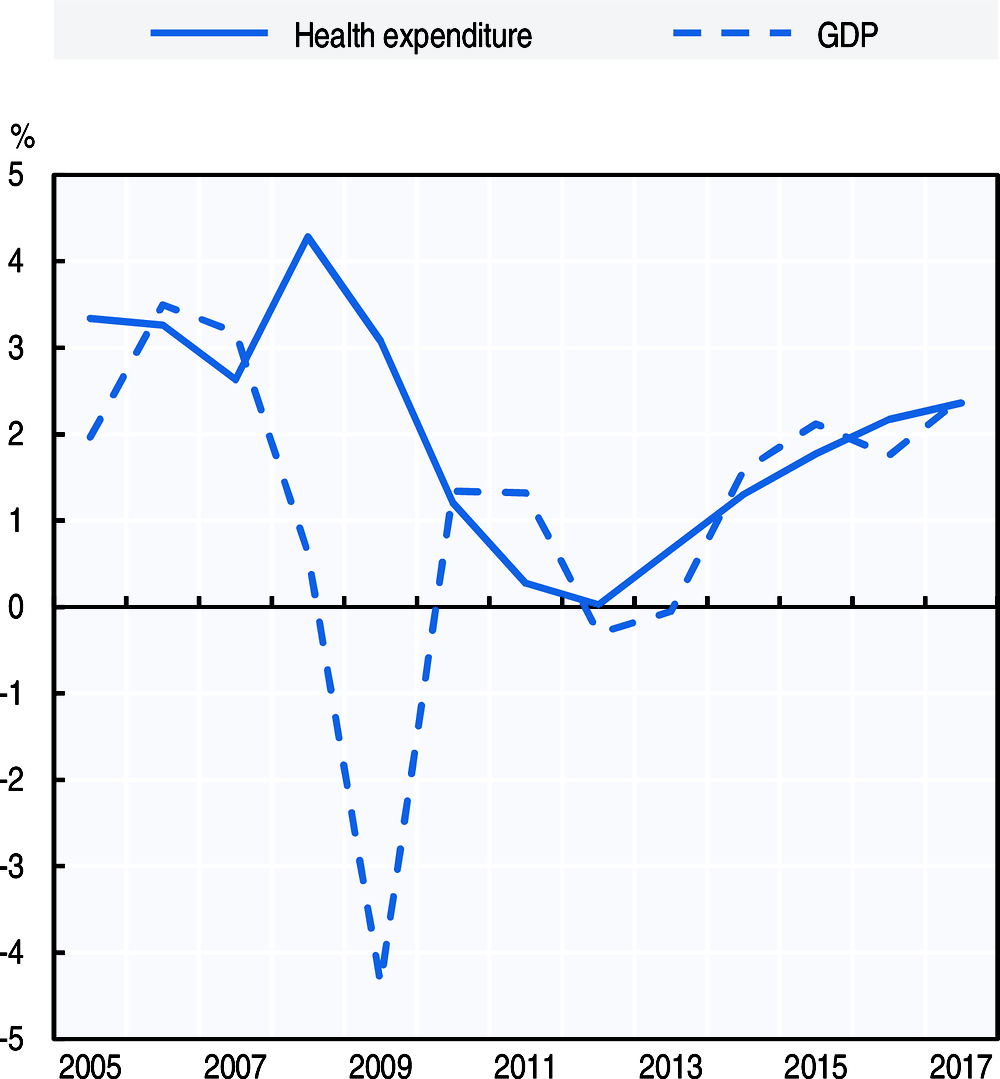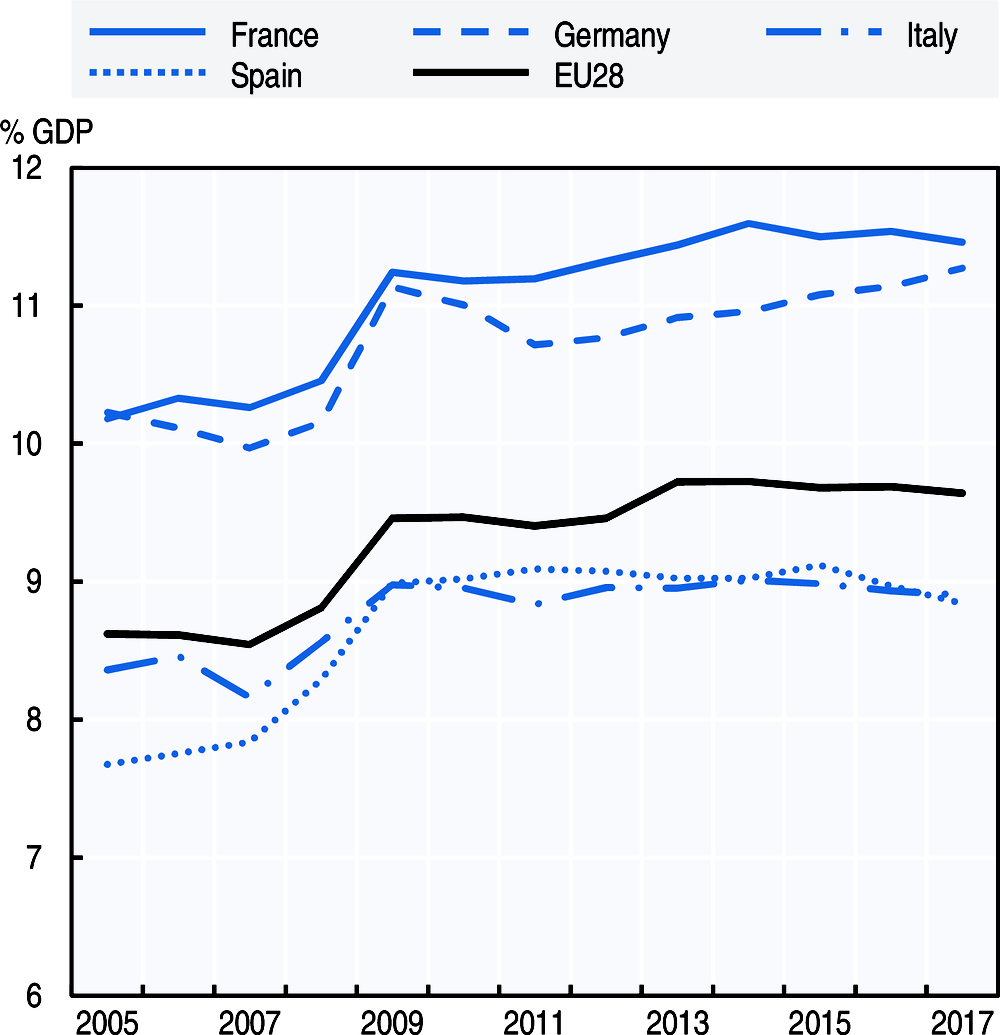Health expenditure in relation to GDP
How much a country spends on health care in relation to all other goods and services in the economy and how that changes over time depends not only on the level of health spending but on the size of the economy as a whole.
In 2017, the EU as a whole devoted 9.6% of its GDP to health care (Figure 5.3). This figure stayed largely unchanged from the levels in both 2015 and 2016 as growth in health spending remained broadly in line with overall economic growth. Among the EU member states, seven had spending on health at 10% or more of GDP, with France (11.5%) and Germany (11.3%) having the highest shares of GDP spent on health. Nevertheless, these shares remain well below that of the United States, where health expenditure accounted for 17.2% of GDP in 2017. At the other end of the scale, the share of health spending in GDP was lowest in Romania (5.2%), Luxembourg (6.1%), Latvia and Lithuania (both at 6.3%). Across all of Europe, Switzerland allocated the biggest share, spending 12.3% of its GDP on health, while Turkey at 4.2% of GDP had the lowest share.
For a better understanding of the different dynamics, the health spending to GDP ratio should be considered together with health spending per capita. While higher income countries tend to devote more of their income to health care, some countries with relatively high health expenditure per capita can have relatively low health spending to GDP ratios, and vice versa. For example, while Slovenia and Bulgaria spent roughly the same share of their GDP on health in 2017, per capita health spending (adjusted to EUR PPP) was 64% higher in Slovenia (see Figure 5.1). Luxembourg, despite having the highest per capita spending in the EU, has one of the lowest shares of health spending relative to GDP. This reflects its high level of economic wealth.
Over time, changes in health spending often reflect changes in GDP, though there is often a lag before changes in economic conditions are reflected in health spending. When overall economic conditions rapidly deteriorated in many European countries from 2008 onwards, overall health spending was initially maintained or even continued to grow (see Figure 5.4). As a result, the health spending to GDP ratio in the European Union jumped sharply to reach 9.6% – up from 8.8% in 2008. After a slight decline – as countries introduced a range of measures in attempts to rein in government health spending and reduce burgeoning budgetary deficits (Morgan and Astolfi, 2014) – the pattern of health expenditure growth per capita has become more aligned to economic growth in many European countries. Consequently, the ratio of health spending to GDP has been relatively stable.
Changes in the ratio of health spending to GDP are the result of the combined effect of growth in both GDP and health expenditure. Even taking into account the economic crisis, the long-term growth in health expenditure per capita (in real terms) in the European Union between 2005 and 2017 has been greater than the growth rate in GDP per capita. With the exception of a handful of countries – Greece, Hungary, Ireland, Luxembourg and Romania – the share of GDP allocated to health has increased in all EU countries.
Looking at some of the larger EU economies, both France and Germany saw their health spending to GDP ratio jump in 2009, stabilise, and then show a gradually increasing trend in subsequent years (Figure 5.5). While Italy and Spain also experienced a similar increase in 2009, growth in health spending has been much more closely aligned with economic growth since then, resulting in the health-to-GDP ratio remaining stable over the last five years or so.
Gross domestic product (GDP) is the sum of final consumption, gross capital formation and net exports. Final consumption includes all the goods and services used by households or the community to satisfy their individual needs. It includes final consumption expenditure of households, general government and non-profit institutions serving households.
Data on health expenditure for 2017 are considered preliminary, either estimated by national authorities or projected by the OECD Secretariat, and are therefore subject to revision.
The GDP figures used to calculate the indicator health expenditure to GDP are based on official GDP data available as of mid-June 2017. Any subsequent revisions to GDP data are not reflected in the indicator.
In countries, such as Ireland and Luxembourg, where a significant proportion of GDP refers to profits exported and not available for national consumption, gross national income (GNI) may be a more meaningful measure than GDP, but for international comparability, GDP is used throughout.
Both GDP and GNI increased significantly in Ireland in 2015 primarily due to the relocation of a limited number of big economic operators to Ireland leading to a substantial drop in the health expenditure to GDP/GNI indicators in that year.
References
Morgan, D. and R. Astolfi (2014), “Health Spending Continues to Stagnate in Many OECD Countries”, OECD Health Working Papers, No. 68, OECD Publishing, Paris, https://doi.org/10.1787/5jz5sq5qnwf5-en.
OECD/Eurostat/WHO (2017), A System of Health Accounts 2011: Revised edition, OECD Publishing, Paris, https://doi.org/10.1787/9789264270985-en.



